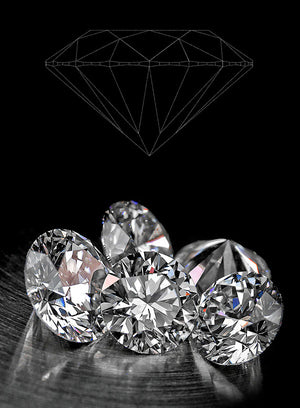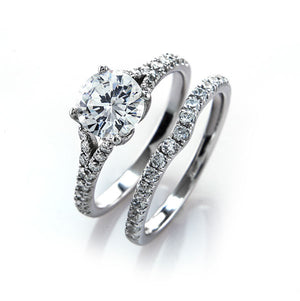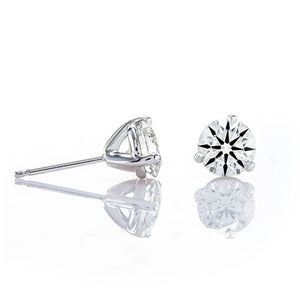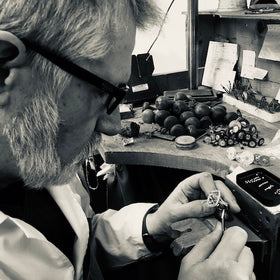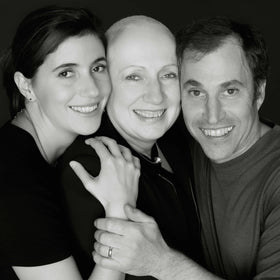Is an M-color diamond too yellow for an engagement ring?
A while back, a client asked whether an M-color diamond is too yellow for an engagement ring. As a matter of fact, he was trying to decide between several Brian Gavin Signature diamonds. In this case the color range was between H-color to M-color. And the carat weight spread across 0.90 to 1.50 carats.
In this particular instance, the only common denominator was the price range he was working within. Consequently, we provided him with the photograph above to make it easier for him to see the difference between
J-M color diamonds.
In this case, the diamonds pictured above are the following:
Obviously, these two diamonds are no longer available. However, the photograph serves to help you distinguish the difference between J-M color diamonds. At least in terms of ideal cut diamonds that exhibit a higher degree of optical precision.
How cut quality affects perception of diamond color:
As you can see, the difference in hue and saturation is very slight between the J-M color diamonds pictured above. One of the reasons for that is the higher degree of optical precision that Brian Gavin’s cutters achieve. That is the consistency of facet shape, size, and alignment.
That factor in combination with the proportions produce a higher degree of light performance. As a result, the M-color diamond on the left, exhibits just a little bit more warmth than the J-color diamond on the right.
Although that may be true, what really stands out is the overall brightness and sparkle factor. As a matter of fact, the overall cut quality practically neutralizes the color difference between these two diamonds. In other words, it is harder to see the difference in hue and saturation because the sparkle factor has a tendency to mask it.
You might have heard that Brian Gavin sets the standard for hearts and arrows diamonds. That’s because he patented the process for maximizing light performance in the modern round brilliant cut diamond. In that case, it’s fair to say that nobody cuts diamonds like Brian Gavin.
As a matter of fact, Brian’s standards are widely recognized for producing the highest volume of light return and sparkle. In fact, the combination of proportions and optical precision produces more virtual facets. Those are the internal kaleidoscope-like reflections of light that result from the overlapping facet pattern.
As a result, there is more sparkle and it will be brighter, and more vivid, than what standard ideal cut diamonds produce. Although that may be true, you can verify the light performance for yourself using the
ASET images provided on the lab report and the diamond details page.
How yellow is an M-color diamond?

Obviously, you’ll spend most of your time looking at your diamond in the face-up position. However, the only way to accurately grade diamond color is from the side profile. In that case, the warmth is more apparent in the
1.530 carat, M-color, VS-2 clarity, Brian Gavin Cape series diamond from the side profile.
Although that may be true, it’s basically a non-issue because it’s not likely that you’re going to spend a lot of time looking at your diamond from this vantage point. Be that as it may, the high-resolution videos that we provide make it easier for you to see the sparkle factor from every vantage point.
Under those circumstances, you can compare how the diamond looks in the face-up position and from the side profile. At the same time, perhaps you can see why
Brian Gavin Cape Series diamonds are a great value. After all, they enable you to afford a larger diamond without sacrificing light performance because the slight difference in hue and saturation is less apparent than you might have thought.
Obviously, you’ll spend most of your time looking at your diamond in the face-up position. However, the only way to accurately grade diamond color is from the side profile. In that case, the warmth is more apparent in the
1.530 carat, M-color, VS-2 clarity, Brian Gavin Cape series diamond from the side profile.
Although that may be true, it’s basically a non-issue because it’s not likely that you’re going to spend a lot of time looking at your diamond from this vantage point. Be that as it may, the high-resolution videos that we provide make it easier for you to see the sparkle factor from every vantage point.
How does diamond color affect price?
As a matter of fact, the cost of these two diamonds are practically the same:
Although that may be true, there is an obvious difference in the size. Especially when you compare them side-by-side as pictured at the top of this page. Under those circumstances, it’s easy to see how much bigger the 1.517 carat is compared with the 1.03 carat. And yet, the difference in hue and saturation is far less noticeable.
Now, imagine that you are looking at those two diamonds from across the dinner table. What do you think you will see most from that perspective? Well, the sparkle factor and light performance, of course!
As a matter of fact, you’d probably be mesmerized by how these Brian Gavin Signature diamonds dance with the light. At the same time, the odds are that you wouldn’t be able to see the difference in diamond color from that distance.
Are K-color Diamonds Good for Engagement Rings?

Since there are a few color grades that span the distance between
J color diamond - M color diamond, we thought that you might appreciate seeing what a K-color diamond looks like. As a matter of fact, K-color diamonds are a very popular choice among our clients.
As you can see, this K-color Brian Gavin Signature diamond still looks bright and white. Although the slightly warmer tones of hue and saturation would be a little easier to see if it were sitting side-by-side an F-G color diamond. Although that may be true, the reality is that only happens when people are trying to decide what diamond color to buy.
Once the ring is on your finger, you’re not likely to give it another thought because the sparkle factor speaks for itself. As a matter of fact, the client who purchased this K-color diamond remarked that it looked much whiter than they anticipated. Once again, that’s the power of the cut quality and the sparkle factor that results from it.
What diamond color should you choose?

Obviously, choosing a diamond color range is largely a matter of personal preference. In this particular instance, our client purchased this
0.908 carat, I-color, VS-2 clarity, Brian Gavin Blue fluorescent diamond. As a matter of fact, the strong blue fluorescence only shows when it is exposed to black light.
As a matter of fact, the presence of blue fluorescence can improve our perception of diamond color. That’s because the blue fluorescence serves to offset some of the yellow undertones that may be present in diamonds of all color grades.
Another thing that can influence the perception of diamond color is the alloy type. In most cases, setting a diamond in white metal prongs is going to make it seem about one color grade whiter and brighter. Whereas setting the same diamond in yellow gold prongs will make it appear to be about one color grade warmer.
Under those circumstances, setting an M-color diamond in white gold prongs tends to make it look closer to L-color. While setting that same diamond in yellow gold prongs will make it look closer to M-color. To be clear, the color of the metal that touches the edge of the diamond is contributing to this effect. As a matter of fact, the color of the setting is of little to no consequence.
Which Brian Gavin Diamond should you choose?
Although Brian Gavin Diamonds are divided into several different collections, there is one thing that remains constant. Specifically, the range of proportions and the degree of optical precision. After all, that is what creates the incredible sparkle factor and light performance that our reputation is built upon.
In that case, you’re free to select a diamond from any of our Signature collections with confidence. Of course, we’ll be happy to help you pick the best option available within the range of characteristics that you prefer.
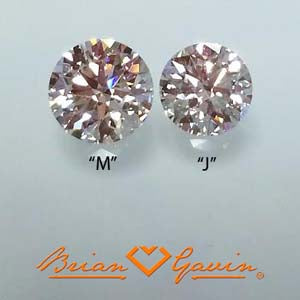
 Obviously, you’ll spend most of your time looking at your diamond in the face-up position. However, the only way to accurately grade diamond color is from the side profile. In that case, the warmth is more apparent in the 1.530 carat, M-color, VS-2 clarity, Brian Gavin Cape series diamond from the side profile.
Although that may be true, it’s basically a non-issue because it’s not likely that you’re going to spend a lot of time looking at your diamond from this vantage point. Be that as it may, the high-resolution videos that we provide make it easier for you to see the sparkle factor from every vantage point.
Under those circumstances, you can compare how the diamond looks in the face-up position and from the side profile. At the same time, perhaps you can see why Brian Gavin Cape Series diamonds are a great value. After all, they enable you to afford a larger diamond without sacrificing light performance because the slight difference in hue and saturation is less apparent than you might have thought.
Obviously, you’ll spend most of your time looking at your diamond in the face-up position. However, the only way to accurately grade diamond color is from the side profile. In that case, the warmth is more apparent in the 1.530 carat, M-color, VS-2 clarity, Brian Gavin Cape series diamond from the side profile.
Although that may be true, it’s basically a non-issue because it’s not likely that you’re going to spend a lot of time looking at your diamond from this vantage point. Be that as it may, the high-resolution videos that we provide make it easier for you to see the sparkle factor from every vantage point.
Obviously, you’ll spend most of your time looking at your diamond in the face-up position. However, the only way to accurately grade diamond color is from the side profile. In that case, the warmth is more apparent in the 1.530 carat, M-color, VS-2 clarity, Brian Gavin Cape series diamond from the side profile.
Although that may be true, it’s basically a non-issue because it’s not likely that you’re going to spend a lot of time looking at your diamond from this vantage point. Be that as it may, the high-resolution videos that we provide make it easier for you to see the sparkle factor from every vantage point.
Under those circumstances, you can compare how the diamond looks in the face-up position and from the side profile. At the same time, perhaps you can see why Brian Gavin Cape Series diamonds are a great value. After all, they enable you to afford a larger diamond without sacrificing light performance because the slight difference in hue and saturation is less apparent than you might have thought.
Obviously, you’ll spend most of your time looking at your diamond in the face-up position. However, the only way to accurately grade diamond color is from the side profile. In that case, the warmth is more apparent in the 1.530 carat, M-color, VS-2 clarity, Brian Gavin Cape series diamond from the side profile.
Although that may be true, it’s basically a non-issue because it’s not likely that you’re going to spend a lot of time looking at your diamond from this vantage point. Be that as it may, the high-resolution videos that we provide make it easier for you to see the sparkle factor from every vantage point.
 Since there are a few color grades that span the distance between J color diamond - M color diamond, we thought that you might appreciate seeing what a K-color diamond looks like. As a matter of fact, K-color diamonds are a very popular choice among our clients.
As you can see, this K-color Brian Gavin Signature diamond still looks bright and white. Although the slightly warmer tones of hue and saturation would be a little easier to see if it were sitting side-by-side an F-G color diamond. Although that may be true, the reality is that only happens when people are trying to decide what diamond color to buy.
Once the ring is on your finger, you’re not likely to give it another thought because the sparkle factor speaks for itself. As a matter of fact, the client who purchased this K-color diamond remarked that it looked much whiter than they anticipated. Once again, that’s the power of the cut quality and the sparkle factor that results from it.
Since there are a few color grades that span the distance between J color diamond - M color diamond, we thought that you might appreciate seeing what a K-color diamond looks like. As a matter of fact, K-color diamonds are a very popular choice among our clients.
As you can see, this K-color Brian Gavin Signature diamond still looks bright and white. Although the slightly warmer tones of hue and saturation would be a little easier to see if it were sitting side-by-side an F-G color diamond. Although that may be true, the reality is that only happens when people are trying to decide what diamond color to buy.
Once the ring is on your finger, you’re not likely to give it another thought because the sparkle factor speaks for itself. As a matter of fact, the client who purchased this K-color diamond remarked that it looked much whiter than they anticipated. Once again, that’s the power of the cut quality and the sparkle factor that results from it.
 Obviously, choosing a diamond color range is largely a matter of personal preference. In this particular instance, our client purchased this 0.908 carat, I-color, VS-2 clarity, Brian Gavin Blue fluorescent diamond. As a matter of fact, the strong blue fluorescence only shows when it is exposed to black light.
As a matter of fact, the presence of blue fluorescence can improve our perception of diamond color. That’s because the blue fluorescence serves to offset some of the yellow undertones that may be present in diamonds of all color grades.
Another thing that can influence the perception of diamond color is the alloy type. In most cases, setting a diamond in white metal prongs is going to make it seem about one color grade whiter and brighter. Whereas setting the same diamond in yellow gold prongs will make it appear to be about one color grade warmer.
Under those circumstances, setting an M-color diamond in white gold prongs tends to make it look closer to L-color. While setting that same diamond in yellow gold prongs will make it look closer to M-color. To be clear, the color of the metal that touches the edge of the diamond is contributing to this effect. As a matter of fact, the color of the setting is of little to no consequence.
Obviously, choosing a diamond color range is largely a matter of personal preference. In this particular instance, our client purchased this 0.908 carat, I-color, VS-2 clarity, Brian Gavin Blue fluorescent diamond. As a matter of fact, the strong blue fluorescence only shows when it is exposed to black light.
As a matter of fact, the presence of blue fluorescence can improve our perception of diamond color. That’s because the blue fluorescence serves to offset some of the yellow undertones that may be present in diamonds of all color grades.
Another thing that can influence the perception of diamond color is the alloy type. In most cases, setting a diamond in white metal prongs is going to make it seem about one color grade whiter and brighter. Whereas setting the same diamond in yellow gold prongs will make it appear to be about one color grade warmer.
Under those circumstances, setting an M-color diamond in white gold prongs tends to make it look closer to L-color. While setting that same diamond in yellow gold prongs will make it look closer to M-color. To be clear, the color of the metal that touches the edge of the diamond is contributing to this effect. As a matter of fact, the color of the setting is of little to no consequence.





